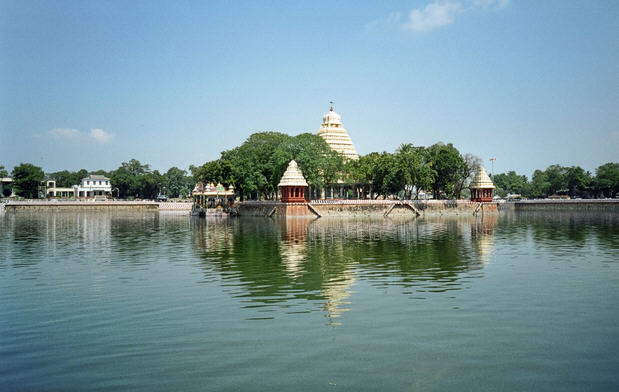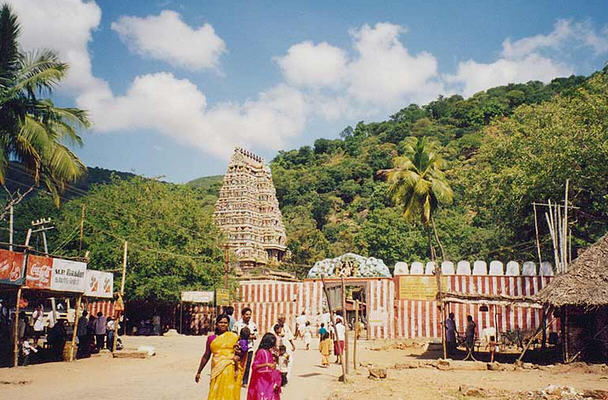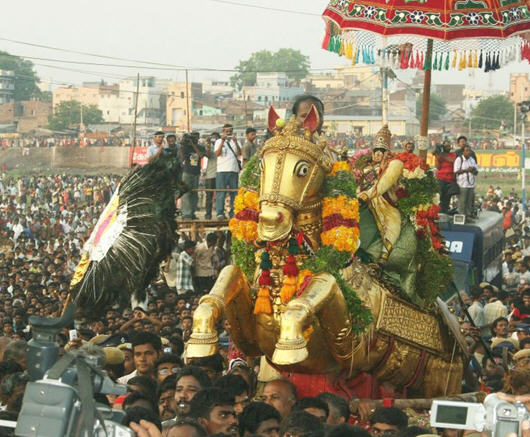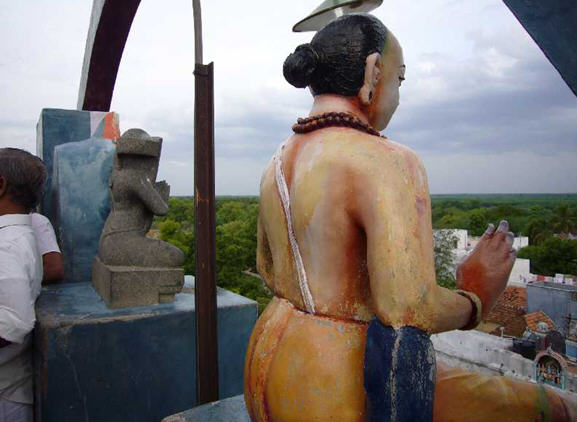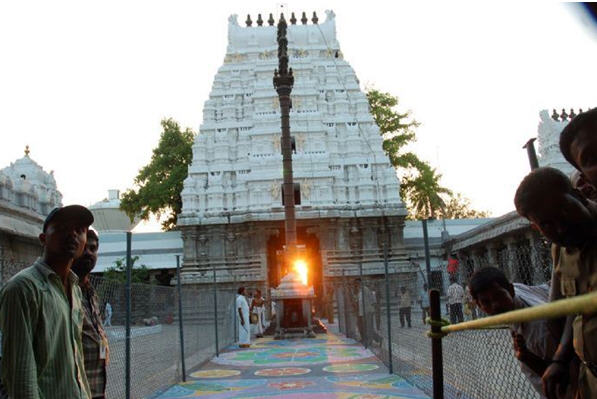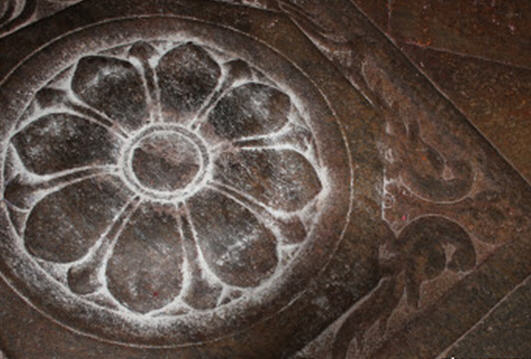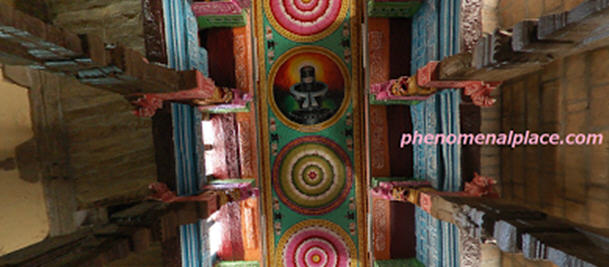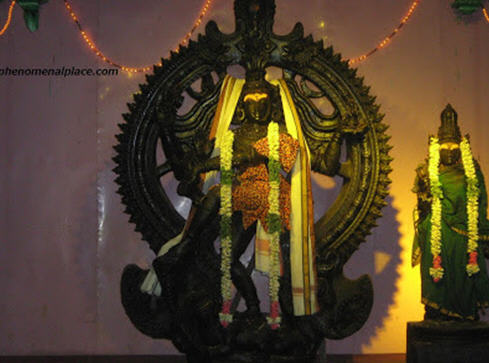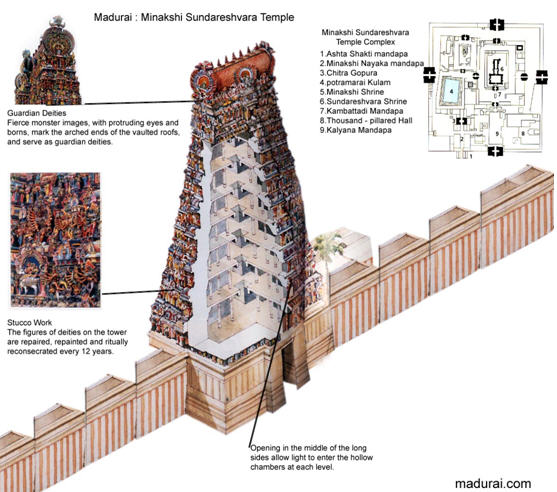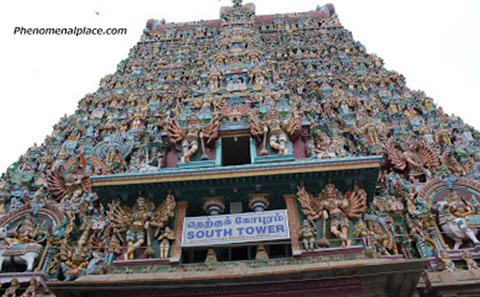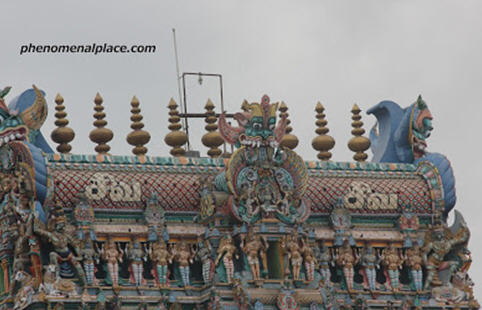(From there He went to Rishabha Mountain, where Lord Krishna also lives, and to the southern Mathura -MADURAI. SB 10.79.11-15.)
Lord Chaitanya visits Madurai :
Daksina-mathura (Southern Mathura) is presently known as the City of Madurai, Tamil Nadu. It’s ancient place name was Madura. Chaitanya charitamrita Madhya lila 9.166
When the Lord arrived at Rishabha Hill, He saw the temple of Lord Narayana and offered obeisances and various prayers.
PURPORT :
Rishabha Hill (Anagada-malaya-parvata) lies twelve miles north of Madurai City, in the district of Madurai, in southern Tamil Nadu. It is one of the mountains known as the Kuttakacalas. Nearby Rishabha Hill is the forest where Lord Rishabhadeva burned Himself to ashes.
Paramananda Puri had stayed at Rishabha Hill during the four months of the rainy season, and when Sri Caitanya Mahaprabhu heard this, He immediately went to see him.Upon meeting Paramananda Puri, Sri Caitanya Mahaprabhu offered him all respects, touching his lotus feet, and Paramananda Puri embraced the Lord in ecstasy. Sri Caitanya Mahaprabhu stayed with Paramananda Puri in the brahmana’s house where he was residing. The two of them passed three days there discussing topics of Krishna.Paramananda Puri informed Sri Caitanya Mahaprabhu that he was going to see Purushottam at JagannathaPuri. After seeing Lord Jagannatha there, he would go to Bengal to bathe in the Ganges.Sri Caitanya Mahaprabhu then told him, “Please return to Jagannatha Puri, for I will return there very soon from Rameshvara [Setubandha].“It is My desire to stay with you, and therefore if you would return to JagannathaPuri, you would show great mercy to Me.” After talking in this way with ParamanandaPuri, the Lord took his permission to leave and, very pleased, departed for southern India.
Daksina-mathura is one of the tirthas Lord Caitanya visited twice during His journey. The significance of both these visits centers upon Mahaprabhu’s interactions with a brahmana, and His delivery to that fortunate soul, whose name was RamadasaVipra, of an original leaf manuscript of the KurmaPurana. This story is told in Madhya lila 9.178 to 218.
9.178: “When Sri Caitanya Mahaprabhu arrived at southern Mathura from Kamakosthi, He met a brahmana.
9.179: The brahmana who met Sri Caitanya Mahaprabhu invited the Lord to his home. This brahmana was a great devotee and an authority on Lord Sri Ramacandra. He was always detached from material activities.
9.180: After bathing in the river Krtamala, Sri Caitanya Mahaprabhu went to the brahmana’s house to take lunch, but He saw that the food was unprepared because the brahmana had not cooked it.
9.181: Seeing this, Sri CaitanyaMahaprabhu said, “My dear sir, please tell Me why you have not cooked. It is already noon.”
9.182: The brahmana replied, “My dear Lord, we are living in the forest. For the time being we cannot get all the ingredients for cooking.
9.183: “When Laksmana brings all the vegetables, fruits and roots from the forest, Sita will do the necessary cooking.”
9.184: Sri CaitanyaMahaprabhu was very satisfied to hear about the brahmana’s method of worship. Finally the brahmana hastily made arrangements for cooking.
9.185: Sri Caitanya Mahaprabhu took His lunch at about three o’clock, but the brahmana, being very sorrowful, fasted. 9.186: While the brahmana was fasting, Sri Caitanya Mahaprabhu asked him, “Why are you fasting? Why are you so unhappy? Why are you so worried?”
9.187: The brahmana replied, “I have no reason to live. I shall give up my life by entering either fire or water.
9.188: “My dear Sir, mother Sita is the mother of the universe and the supreme goddess of fortune. She has been touched by the demon Ravana, and I am troubled upon hearing this news.
9.189: “Sir, due to my unhappiness I cannot continue living. Although my body is burning, my life is not leaving.”
9.190: Sri Caitanya Mahaprabhu replied, “Please do not think this way any longer. You are a learned pandita. Why don’t you consider the case?”
9.191: Sri Caitanya Mahaprabhu continued, “Sitadevi, the dearmost wife of the Supreme Lord Ramacandra, certainly has a spiritual form full of bliss. No one can see her with material eyes, for no materialist has such power.
9.192: “To say nothing of touching mother Sita, a person with material senses cannot even see her. When Ravana kidnapped her, he kidnapped only her material, illusory form.
9.193: “As soon as Ravana arrived before Sita, she disappeared. Then just to cheat Ravana she sent an illusory, material form.
9.194: “Spiritual substance is never within the jurisdiction of the material conception. This is always the verdict of the Vedas and Puranas.”
9.195: Sri Caitanya Mahaprabhu then assured the brahmana, “Have faith in My words and do not burden your mind any longer with this misconception.”
9.196: Although the brahmana was fasting, he had faith in the words of Sri Caitanya Mahaprabhu and accepted food. In this way his life was saved.
9.197: After thus assuring the brahmana, Sri Caitanya Mahaprabhu proceeded further into southern India and finally arrived at Durvasana, where He bathed in the river Krtamala.
PURPORT :
Presently the Krtamala River is known as the river Bhagai or Vaigai. This river has three tributaries, named Suruli, Varaha-nadi and Battilla-gundu. The river Krtamala is also mentioned in Srimad-Bhagavatam (11.5.39) by the sage Karabhajana.
9.198: At Durvasana Sri Caitanya Mahaprabhu visited the temple of Lord Ramacandra, and on the hill known as Mahendra-saila He saw Lord Parasurama.
9.199: Sri CaitanyaMahaprabhu then went to Setubandha [Ramesvara], where He took His bath at the place called Dhanus-tirtha. From there He visited the Ramesvara temple and then took rest.
9.200: There, among the brahmanas, Sri Caitanya Mahaprabhu listened to the KurmaPurana, wherein is mentioned the chaste woman’s narration.
PURPORT
Srila Bhaktisiddhanta Sarasvati Thakura remarks that only two khandas of the Kurma Purana are now available, namely the Purva-khanda and Uttara-khanda. Sometimes it is said that the Kurma Purana contains six thousand verses, but according to Srimad-Bhagavatam the original Kurma Purana contains seventeen thousand verses. It is considered the fifteenth of the eighteen Maha-puranas.
9.201: Srimati Sitadevi is the mother of the three worlds and the wife of Lord Ramacandra. Among chaste women she is supreme, and she is the daughter of King Janaka.
9.202: When Ravana came to kidnap mother Sita and she saw him, she took shelter of the fire-god, Agni. The fire-god covered the body of mother Sita, and in this way she was protected from the hands of Ravana.
9.203: Upon hearing from the Kurma Purana how Ravana had kidnapped a false form of mother Sita, Sri Caitanya Mahaprabhu became very satisfied.
9.204: The fire-god, Agni, took away the real Sita and brought her to the place of Parvati, goddess Durga. An illusory form of mother Sita was then delivered to Ravana, and in this way Ravana was cheated.
9.205: After Ravana was killed by Lord Ramacandra, Sitadevi was brought before the fire and tested.
9.206: When the illusory Sita was brought before the fire by Lord Ramacandra, the fire-god made the illusory form disappear and delivered the real Sita to Lord Ramacandra.
9.207: When Sri CaitanyaMahaprabhu heard this story, He was very pleased, and He remembered the words of RamadasaVipra.
9.208: Indeed, when Sri Caitanya Mahaprabhu heard these conclusive statements from the Kurma Purana, He felt great happiness. After asking the brahmanas’ permission, He took possession of the manuscript leaves of the Kurma Purana.
9.209: Since the Kurma Purana was very old, the manuscript was also very old. Sri Caitanya Mahaprabhu took possession of the original leaves in order to have direct evidence. The text was copied into new leaves in order that the Purana be replaced.
9.210: Sri Caitanya Mahaprabhu returned to southern Mathura [Madurai] and delivered the original manuscript of the KurmaPurana to RamadasaVipra.
9.211-212: “When he was petitioned by mother Sita, the fire-god, Agni, brought forth an illusory form of Sita, and Ravana, who had ten heads, kidnapped the false Sita. The original Sita then went to the abode of the fire-god. When Lord Ramacandra tested the body of Sita, it was the false, illusory Sita that entered the fire. At that time the fire-god brought the original Sita from his abode and delivered her to Lord Ramacandra.”
PURPORT
These two verses are taken from the Kurma Purana. 9.213: RamadasaVipra was very pleased to receive the original leaf manuscript of the Kurma Purana, and he immediately fell down before the lotus feet of Sri Caitanya Mahaprabhu and began to cry.
9.214: After receiving the manuscript, the brahmana, being very pleased, said, “Sir, You are Lord Ramacandra Himself and have come in the dress of a sannyasi to give me audience.
9.215: “My dear Sir, You have delivered me from a very unhappy condition. I request that You take Your lunch at my place. Please accept this invitation.
9.216: “Due to my mental distress I could not give You a very nice lunch the other day. Now, by good fortune, You have come again to my home.”
9.217: Saying this, the brahmana very happily cooked food, and a first-class dinner was offered to Sri Caitanya Mahaprabhu.
9.218: Sri Caitanya Mahaprabhu passed that night in the house of the brahmana. Then, after showing him mercy, the Lord started toward the Tamraparni River in Pandya-desa.”
